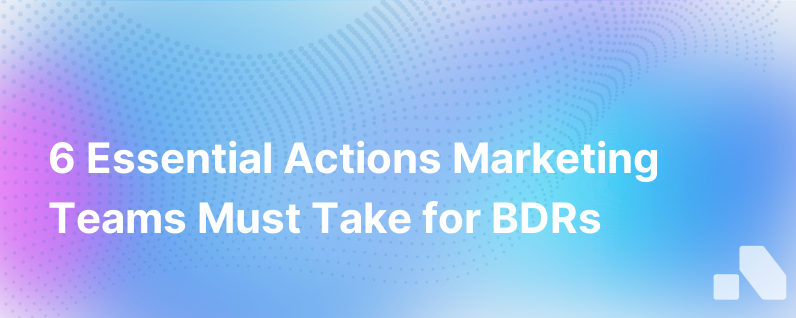
In today’s hyper-competitive business environment, a seamless collaboration between marketing teams and business development representatives (BDRs) can be a tremendous catalyst for growth. Marketing equips BDRs with the tools, insights, and leads necessary to drive sales. However, despite the critical nature of this relationship, there are certain crucial tasks that marketing teams should but often don’t perform for BDRs. Here, we outline six crucial things marketing teams should regularly do to empower BDRs.
1. Provide Tailored Content
BDRs need an arsenal of content that speaks directly to the various pain points and interests of potential customers. This content ranges from blogs and whitepapers to case studies and infographics. Marketing teams often churn out generic content aimed at a broad audience. This approach can make BDR outreach less effective.
What marketing should do:
- Collaborate with BDRs to understand specific customer personas.
- Develop targeted content that addresses specific industry challenges and questions that leads have.
- Create content that is customizable for BDRs, allowing them to personalize materials for their outreach and follow-up.
2. Share Rich Lead Intelligence
While BDRs can work with basic lead information, richer lead intelligence allows them to have more informed, meaningful conversations with potential customers. Marketing teams typically have access to data from various touchpoints that can offer insights into the buyer’s journey and interest level.
What marketing should do:
- Use analytics and marketing automation tools to track lead behavior and engagement.
- Share insights on which pieces of content the leads engaged with, what events they attended, and other interactions with the brand.
- Aggregate behavioral data to give BDRs a fuller picture of the lead's interests and potential pain points.
3. Offer Continuous Training on Product and Brand Messaging
BDRs should be masters of brand messaging and product details to communicate effectively with prospects. Unfortunately, in the rush of campaigns and product launches, marketing teams might overlook the importance of continuously training BDRs.
What marketing should do:
- Arrange regular training sessions that keep BDRs up-to-date on product features, benefits, and differentiators.
- Provide BDRs with messaging that adapts to market changes or emerging trends.
- Develop cheat sheets for BDRs, encapsulating key messaging points for quick reference.
4. Implement Systems for Easy Personalization
The era of mass, unpersonalized email blasts is over. Today’s prospects expect communication tailored to their specific needs. However, personalization at scale can be challenging. Marketing teams sometimes provide one-size-fits-all materials that BDRs struggle to personalize.
What marketing should do:
- Equip BDRs with CRM and marketing automation tools that enable personalization of emails and content at scale.
- Provide templates that have customization options for various stages of the customer journey.
- Ensure that the marketing tech stack easily integrates with the tools used by BDRs.
5. Facilitate Social Selling Capabilities
Social selling is an integral part of today's BDR toolkit. While BDRs are responsible for their own presence on social channels like LinkedIn, marketing can amplify their effectiveness by providing support and guidance.
What marketing should do:
- Train BDRs on best practices for social selling and personal branding.
- Provide content libraries with shareable, socially-optimized content.
- Measure the impact of social selling efforts and refine strategies based on performance data.
6. Ensure Closed-Loop Feedback Processes
A feedback loop between BDRs and marketing is essential for the continuous fine-tuning of strategies and tactics. Unfortunately, it’s common for marketing teams to work in silos, disconnected from the feedback that BDRs can provide from real-world conversations with prospects.
What marketing should do:
- Establish regular forums for BDRs to provide feedback on lead quality, content effectiveness, and messaging resonance.
- Use insights from BDRs to refine lead scoring models and qualification criteria.
- Iterate on content and strategy based on BDRs’ experiences with customer pain points and objections.
The Combined Power of BDRs and Marketing
When marketing teams undertake these six actions, they enable BDRs to engage in more meaningful conversations, focus on high-quality leads, and close deals more effectively. Each of these responsibilities serves to bridge the gap between the broad audience targeting typical of early-funnel marketing activities and the one-on-one personalized engagement that defines successful BDR outreach.
BDRs are the front line of interaction with potential customers and thus hold invaluable insights into customer needs, objections, and buying signals. By sharing tailored content, rich lead intelligence, updated training, personalization tools, social selling capabilities, and feedback mechanisms, marketing can empower BDRs to perform their pivotal role to the fullest.
Marketing teams armed with analytics and creative acumen and BDRs equipped with insights and tools to engage prospects are a formidable combination. Organizations that align their marketing teams and BDRs closely will see a marked improvement in lead conversion rates, sales cycle times, and ultimately, revenue growth.
In conclusion, by taking the initiative on these six tasks, marketing teams can provide BDRs with essential support, transforming both the efficiency and impact of outreach efforts. This synergistic relationship is not just about making BDRs' lives easier; it's a strategy for driving business development and scaling growth within competitive markets.